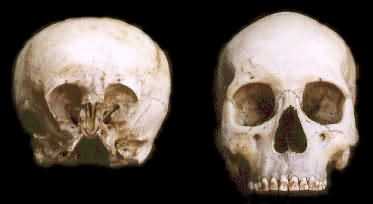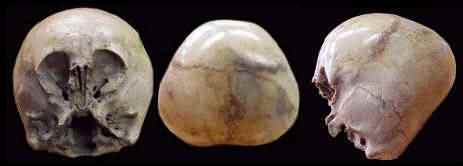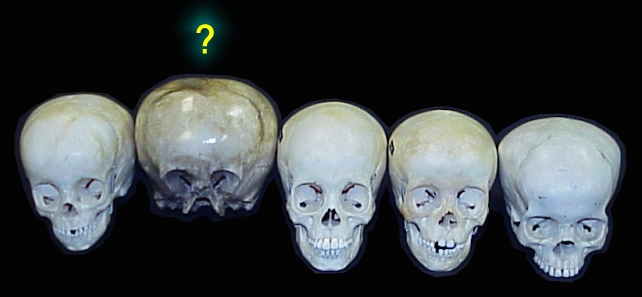|
Skulls are humanity's foremost symbol of death, and a powerful icon
in the visual vocabularies of cultures all over the globe.
Many strangely "deformed" hominoid skulls have been discovered in
Mexico and Peru. One of them, the Starchild skull found in Mexico,
is currently the subject of scientific scrutiny and DNA testing.
Thirteen
crystal skulls of apparently ancient origin have been found
in parts of Mexico, Central America and South America, comprising
one of the most fascinating subjects of 20th Century archaeology.
Introduction
In the 1930's, in a small rural village 100 miles southwest of
Chihuahua, Mexico,
at the back of a mine tunnel, two mysterious remains were found: a
complete human skeleton and a smaller, malformed skeleton.
In late February of 1999, Lloyd Pye was first shown the Starchild
skull by its owners. Nameless then, it was a highly anomalous skull.
He initially felt it would prove to be a rare genetic deformity of
some kind. This skull’s symmetry was astonishing, even more so than
the average human. In fact, all of its bones—most of which had human
counterparts—were beautifully shaped.
But shaped like what?
Solving
many questions that this unusual skull presented became his
challenge.
|

Front view of the Starchild skull (on the left) and the human skull
(on the right).
Compare striking differences between depth of eye sockets and shape
of temporal
area just behind outer edges of eyes. |
Skull Discovery
Sixty to seventy years ago an American girl of Mexican heritage in
her late teens (15 to 18) was taken by her parents to visit
relatives living in a small rural village 100 miles southwest of
Chihuahua, Mexico. The girl was forbidden to enter any of the area's
numerous caves and mine tunnels, but like most teenagers, she went
exploring. At the back of a mine tunnel she found a complete human
skeleton lying on the ground's surface.
Beside it, sticking up out
of the ground, was a malformed skeletal hand entwined in one of the
human skeleton's upper arms. The girl proceeded to scrape the dirt
off a shallow grave to reveal a buried skeleton smaller than the
human one and also malformed. She did not specify the type or degree
of any of the "malformations."
The girl recovered both skulls and kept them for the remainder of
her life. Upon her death they were passed to an American man, who
maintained possession for five years before passing them to the
American couple who now control them.
The Mystery Skull
Skull suturing and baby teeth in a detached piece of maxilla (upper
jaw and palate) indicate death around 5 years of age. The face is
missing from the upper bridge of the nose to the foramen magnum (the
hole where the spine enters the skull), but the cranium and most of
both eye orbits (the external parts of the sockets) are intact.
This skull's degree of humanity is at issue because several aspects
of its morphology defy categorizing as genetic defect (inherited),
congenital deformation (birth defect), or inflicted deformity
(cranial binding).
The Human Skull
A human skull assumed to be Amerindian (an Indian from North or
South America) because the rear of its cranium exhibits the
flattening that results from being carried in infancy on a cradle
board. Tooth wear suggests age at death
was around 25 years, plus or minus five. Its smallish size and other
reduced points of reference indicate it will likely prove to be
female.
Binding
Experts suggest the child's high degree of occipital (rear-skull)
deformity would most likely have resulted from the cranial binding
practiced by primitive cultures around the world. However, such
binding never extends below the inion (the bump at the back of the
head) because the human neck begins just below that point.
Furthermore, squeezing a skull's upper bones out of their natural
shape leaves them permanently separated, which results in a
life-long "soft spot" at the top of the head.
The child's skull is well-sutured (no soft spot), with none of the
distortions normally caused by binding. Furthermore, the extent of
rear flattening extends well past the inion, which has become
slightly concave.
This indicates a strong force other than binding
(i.e. pathology or a natural design) must have caused the
occipital's extensive deformation.
Brain Volume
Though markedly different in shape, the skulls are roughly the same
size. However, they exhibit a stunning difference in brain volume.
The average volume for a human brain is 1400 cubic centimeters (cc).
The volume of the human skull is 1200 cc, typical for a small human.
In contrast, the volume of the child's skull is 1600 cc, which is
200 cc beyond the average for adult humans.
And had it lived to
become an adult, its brain capacity would have grown to 1800 cc or
more, well beyond the human average.
|

The Starchild's brain volume, contained inside a cranium the size of
a smallish human's,
is 1600 cc. A normal human skull has a brain volume around 1400
cubic centimeters. |
In paleoanthropology (the study of ancient animals) a 200 cc
increase in brain capacity of a human type creature warrants the
naming of an entirely new species. Homo Erectus averages 200 cc more
than Homo Habilis; Homo Archaic is 200 cc more than Erectus;
Neanderthal is 200 cc more than Archaic.
Thus, this child might well
represent an unknown species of human-like beings.
Weight
An average human skull weighs 2.2 pounds (lbs.). The adult's skull
(which is missing its lower jawbone and teeth) weighs 1 lb., 13.4
ounces. Including the child skull's piece of detached maxilla (upper
jaw), it weighs only 13.5 ounces.
Because it is roughly the size of
the adult skull, its bone has to be significantly lighter than
typical human
bone.
Symmetry
The child's skull has a high degree of symmetry (similarity on both
sides). Usually cranial pathologies will cause differences in degree
on either side of the head, along with other distortions.
Thus, it
is highly unlikely a cranium so clearly aberrant would exhibit such
startling symmetry throughout
Sutures
A CAT scan has shown that none of the sutures between the bones in
the child's skull have sealed themselves off from further growth.
Nearly all examples of congenital deformity exhibit some degree of
premature sealing of cranial sutures. This makes it highly unlikely,
if not virtually impossible, for the child's skull to be the result
of deformity. It seems to have grown naturally into the shape is had
taken.
The Eyes
Normal human eye sockets have a recessed (5 cm) conical shape with
optic nerves and optic fissures at the inner rear quadrant of the
cone. The child's eye sockets have a shallow (3 cm) scalloped shape
with optic nerves and optic fissures moved down and away to the
inner bottom. Also, the inner surface of both sockets have
incredibly subtle terrain shifts that are impossible to explain in
any way other than genetic design.
The shape and width of the eye orbits (the outer edges of the
sockets) are equally divergent. The adult's have the vaguely
rectangular shape of normal humans, while the child's are shaped
like a lopsided oval. The adult's are typically rounded along the
top of the rectangle, while the upper part of the child's oval has a
clearly definable edge.
The Ears
The child's ear canals are clearly visible on both sides of its
skull. They seem normal in shape and size and angle of entry, but a
recent CAT scan revealed that they are larger and have more depth
than normal human inner ears. There is no way to know if an external
ear was present or what it may have looked like.
The Sinuses
The child had small maxillary (cheek) sinuses but no trace of
frontal sinus cavities. While extremely rare, this condition is
supposedly known among both humans and primates.
The Foramen Magnum
The foramen magnum is the hole at the base of the skull where the
spinal column connects with the brain. In normal humans the foramen
is positioned slightly rear of center to balance the hollow-filled
front face against the brain-filled occipital area. The extensive
reconfiguration of the child's skull has somehow caused its foramen
magnum to be shifted to a central point that provides much better
balance between its rear brain area, and its face and forebrain.
The Necks
Typical human neck attachments begin at the inion, the bump in the
middle of the occipital bone, and sweep out in a semicircle that
reaches to just behind the ears and converges at the foramen magnum.
The distance from any part of the semicircle to the foramen opening
averages 5 to 6 centimeters.
In the child's skull a shallow arc extends about 3 centimeters from
the foramen hole, while the inion has somehow become slightly
concave. Such a drastic reduction in attachment area means the neck
supporting the child's head must have been from 1/2 to 1/3 that of a
normal human. Such thin necks are consistently described as
hallmarks of certain alien types (Grays), and of Gray-human hybrids.
Chewing Muscles
In the child, the area available for attaching chewing muscles is
every bit as reduced as the attachment area for its neck muscles.
And though they are called "chewing" muscles, they are actually used
for connecting and holding the lower face to the skull.
Based on
such a reduced connection area, the amount of mandible (jawbone)
these muscles could have secured must have been greatly reduced.
Human-Alien Hybrids
Many abductees and contactees allege that aliens (most often
"Grays") are conducting genetic experiments that produce hybrids
between themselves and humans. The results of these unions are
consistently described as looking far more human than alien, but
with stark bulges in the parietal bones; shallow eye sockets; a
greatly reduced lower face; a thin neck able to easily support a
well-balanced head; and ears seen as markedly lower and smaller (or
missing entirely) relative to human ears.
The eyes of Grays are consistently described and depicted as large
black teardrop shapes that wrap horizontally across the middle of
the face. If those large orbs are indeed their visual mechanisms, it
would argue against the child's eyes being related to them.
However,
in the "Alien Autopsy" film the alien being dissected has the
"standard" Gray eyes until the doctor performing the autopsy lifts
them off and shows them to actually be dark, flexible coverings like
large contact lenses or shades. Underneath those lenses were round,
bulging eyes with plenty of white showing around dark irises.
Those
eyes would fit quite well in the reduced eye sockets of the child.
The Star Being Legends
These are well-known, well-regarded legends with roots spreading
throughout Central and South America. They are pervasive and
long-standing (two centuries or more), and in general state that on
a regular basis "Star Beings" come down from the heavens and
impregnate females in remote, isolated villages. The women carry
their "starchildren" to term, then raise them to age six or so.
At
that point the Star Beings return to collect their progeny and
remove them to places, and for purposes, not clearly outlined in the
legends, though improving a stagnated gene pool is often mentioned
as a motivation.
The Non-Traditional Scenario
Many "intuitives" and "sensitives" feel the adult skeleton was a
female and the child was hers, a human-alien hybrid created by a
union between her and a Star Being. Some feel the mother had learned
the Star Beings were returning to take her child from her, which she
refused to contemplate.
Panic-stricken and filled with dread, she
took her child and fled her village, seeking refuge in the hidden
mine tunnel. There she killed it and buried it in a shallow grave,
leaving one of its hands out of the ground to hold onto.
Then she
took a fatal dose of poison and lay down beside her child to die.
DNA Testing
Inside the nucleus of human cells is found nuclear DNA, which is a
combination of both parents. Floating outside the nucleus in each of
our cells are tiny bits of stray DNA called "mitochondria." Because
mitochondrial DNA (mtDNA) passes solely through females, the first
test of the child's mtDNA will provide a genetic snapshot of its
mother. If she was human, that snapshot will say "human."
However,
since the test says nothing about the father, that does not preclude
it being a human-alien hybrid. Furthermore, testing might indicate
an utterly non-human origin, either by having entirely absent mtDNA
or by having a structure markedly different from human mtDNA.
Nothing is likely to be definitive about the origin of the child's
skull until its nuclear DNA can be tested. Because the skull is
considered technically "ancient" (over 50 years of age), recovering
nuclear DNA will be difficult and costly. Luckily, we have what is
most required for such a test, which is teeth. The pulp in teeth
resists deterioration better than any other part of the body, so
that is where we must look for nuclear DNA.
Worldwide there are only a handful of laboratories capable of
sequencing ancient nuclear DNA, and all such processes are
time-consuming, highly technical, and very expensive.
Thus, we
cannot contract to have this testing done until funding is available
to pay for it, but we will announce all such results as soon as they
are available.
Starchild Updates:
Mainstream Position:
Pathology--genetic (inherited) or congenital (birth defect)--is the
standard explanation for any human-like skull that does not fit the
"normal" human mold. In the hands of scientists dedicated to pounding
square pegs into the round hole of conventional thinking,
pathology can be made to cover virtually any deviation.
In truth, a unique combination of extraordinary pathological
disorders is a possible explanation for the many aberrations evident
in the child's skull. Absent overwhelming evidence to the contrary,
mainstream science will insist the skull has resulted from nothing
more than multiple pathological defects.
This opinion will always dominate any others because of the combined
academic credentials of those who will profess it.
This is reality; we all know it.
Points Supporting Non-Earth Origin
The long-standing Star Being legends of Central and South America
provide a plausible mechanism for how a highly abnormal skull
(relative to humans) might have been biologically created rather
than genetically or congenitally malformed, or physically
manipulated by deliberate deformation (binding).
Such immense deformation across the entire occipital (rear) and
parietal (upper side) areas of the skull could not result from
binding without deformation being visible in the frontal area, which
is not evident.
Birth defects across the entire occipital and parietal areas, while
not impossible, seem highly unlikely because of the remarkable
symmetry exhibited in all areas of the skull, including those
effected by the deformations.
The terrain of the bone in the eye sockets contains incredibly
subtle indentations and ridges that are perfectly symmetrical in
both sockets, which simply have to have been formed by genetic
directions rather than by deformations.
The rear deformation extends from the crown to very near the foramen
magnum, an area impossible to reach by any binding device due to the
thick neck muscles (even in a child) that surround and support the
skull-spine connection.
Head binding cannot extend below the inion (the bump at the back of
the head).
Head binding leaves a gaping opening at the top where skull bones
fail to fuse.
The bottom line is that even though the skull's highly unusual
characteristics demand an open-minded approach to it, mainstream
science will reject it outright until forced by DNA evidence to do
otherwise. Indeed, it could turn out to be nothing more than a
butt-ugly kid with an extraordinary combination of cranial
deformities never seen before. But it could also have been the
result of a human-alien union, or an outright alien with no
connection to humanity at all.
Only time and testing will tell which possibility is correct.
For more information read below:
|


